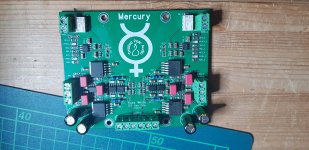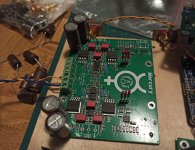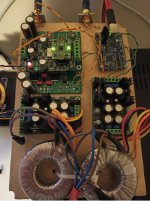Resistor value for 2 Buffalo SEiii Dual mono connected to 1 Mercury card .
Hello everyone ,sorry to bother you all .I have 2 Buffalo SEiii DACs in dual mono and would like to connect to 1 Mercury card ,I have 2 tube amps and they need 1.56 volts for each input for full volume.
Trying to work out the gain value and what resistors i need.I have read the thread and tried to understand best i can what values i would need for R1 1 R1 2 R2 1 and R2 2 .
Please is there anyone who could be so kind and give me the values needed,it would be very appreciated.
Thanking you all again .
Regards shaun .
Hello everyone ,sorry to bother you all .I have 2 Buffalo SEiii DACs in dual mono and would like to connect to 1 Mercury card ,I have 2 tube amps and they need 1.56 volts for each input for full volume.
Trying to work out the gain value and what resistors i need.I have read the thread and tried to understand best i can what values i would need for R1 1 R1 2 R2 1 and R2 2 .
Please is there anyone who could be so kind and give me the values needed,it would be very appreciated.
Thanking you all again .
Regards shaun .
1. Which versions of the B3se are you using?
2. If you channel the output of an entire DAC into one Mercury channel then none of the included resistors will be very close to what you want to achieve. The included resistors typically give about 2v RMS or 2.8v peak-to-peak from half of one Buffalo. A bit less than half of the suggested resistance for your DACs might be a good start, but you didn't specify if the 1.56v you want is peak-to-peak or RMS.
...looks like an opportunity for trial and measurement.
2. If you channel the output of an entire DAC into one Mercury channel then none of the included resistors will be very close to what you want to achieve. The included resistors typically give about 2v RMS or 2.8v peak-to-peak from half of one Buffalo. A bit less than half of the suggested resistance for your DACs might be a good start, but you didn't specify if the 1.56v you want is peak-to-peak or RMS.
...looks like an opportunity for trial and measurement.
the operating point is dynamic! I observed this by placing a scope probe at the common input point and observed a sine wave at full scale at lower frequencies…
Can you please share what are the frequencies of these oscillations (what range) ?
What is the corner frequency of the VOCM servo?
Best
Marek
1. Which versions of the B3se are you using?
2. If you channel the output of an entire DAC into one Mercury channel then none of the included resistors will be very close to what you want to achieve. The included resistors typically give about 2v RMS or 2.8v peak-to-peak from half of one Buffalo. A bit less than half of the suggested resistance for your DACs might be a good start, but you didn't specify if the 1.56v you want is peak-to-peak or RMS.
...looks like an opportunity for trial and measurement.
Thank you for answering .
The manufacturere of the Tube amp informed the Voltage of 1.56 is RMS and there is trim pots if you only need to adjust a few dB.
The Buffalo B3se has version 1.0 on the circuit board and the Dacs have 9018 chips.
Very kind of you to help me ,hope this information can help you further to justify what resistors i will need .Thank you again .
Very good.
The smaller the resistance the lower the output from the Mercury. The stock resistor for 2v RMS from 1/2 of an ES9038Pro is 60 ohms and (IIRC) both halves of a 9018 give as much current as one half of one side of the 9038. So I get:
60 ohms * 2 (current factor) * 1.56/2 (voltage factor) = 93.6 ohms
So 90-95 ohms should be fine unless I mis-thunk. Order 0.1% tolerance if at all possible.
Meanwhile, my experience with the older 9018s into the Mercury has been very positive, so I am enthusiastic for your results once you have it dialed in.
Cheers,
Frank
The smaller the resistance the lower the output from the Mercury. The stock resistor for 2v RMS from 1/2 of an ES9038Pro is 60 ohms and (IIRC) both halves of a 9018 give as much current as one half of one side of the 9038. So I get:
60 ohms * 2 (current factor) * 1.56/2 (voltage factor) = 93.6 ohms
So 90-95 ohms should be fine unless I mis-thunk. Order 0.1% tolerance if at all possible.
Meanwhile, my experience with the older 9018s into the Mercury has been very positive, so I am enthusiastic for your results once you have it dialed in.
Cheers,
Frank
measuring 0.7 Ohms on SE out put
Hello ,
Nearly ready to power up my brand new Mercury card ,but measured 0.7 Ohms on the left and right SE out puts ,is this correct .
I have a old IVYIII and that measures 22 Ohms on the SE left and right out puts .
I do know twisted pair audio had a card that the components were mounted upside down and the customer got a new card .Please take a look and see on the image if all is well .Are the relays mounted correctly .found a simular post and i followed that for the orientation of the left and right relays .
Thanking you all again so much .
Regards shaun .
Hello ,
Nearly ready to power up my brand new Mercury card ,but measured 0.7 Ohms on the left and right SE out puts ,is this correct .
I have a old IVYIII and that measures 22 Ohms on the SE left and right out puts .
I do know twisted pair audio had a card that the components were mounted upside down and the customer got a new card .Please take a look and see on the image if all is well .Are the relays mounted correctly .found a simular post and i followed that for the orientation of the left and right relays .
Thanking you all again so much .
Regards shaun .
Attachments
Thank you
Hello Stephan1212b,
Very kind of you to answer so fast ,really happy about the support people get on DIY Audio,great place to be .
I am running dual mono configeration and will solder the DACs directly to the Mercury ,yes i do admit it looks messing ,cleaned up now and looking much better .
Now i can continue and soon good music playing this weekend.
Thank you again for your kind support .
Regards Shaun
Hello Stephan1212b,
Very kind of you to answer so fast ,really happy about the support people get on DIY Audio,great place to be .
I am running dual mono configeration and will solder the DACs directly to the Mercury ,yes i do admit it looks messing ,cleaned up now and looking much better .
Now i can continue and soon good music playing this weekend.
Thank you again for your kind support .
Regards Shaun
One small layout suggestion: test the system with signal wires that are long enough so each Buffalo can mount separately beside the Mercury. When you are satisfied, you could shorten those wires if you stack the Buffalo 3s on each side of the Mercury using two different standoffs - one into the Mercury that is just long enough to clear Mercury's electrolytic caps, and one longer one that supports the free edge of each Buffalo. The vertical layering feature of the B3's component design is very nice, and serves a purpose.
Cheers!
Cheers!
Hi,
I have been trying to get the best possible sound from rescently acquired B2 dac with legato output stage. I only use SE output so I had to deal with bal/se stage... I changed many opamps but never was satisfied with the sound comoletely. My friend has B2 with legato but for bal/se he is using ventus, and I could never get close to them even when using really great opamps like opa1612 etc...
So I tried to go with Mercury... Boy does it make a difference.
It delivers hugely detailed and powerful sound, and I just can't belive how different can one dac sound based on output stage only.
Next step would be to upgrade power supply, but at this moment I just want to listen more muzaak
I have been trying to get the best possible sound from rescently acquired B2 dac with legato output stage. I only use SE output so I had to deal with bal/se stage... I changed many opamps but never was satisfied with the sound comoletely. My friend has B2 with legato but for bal/se he is using ventus, and I could never get close to them even when using really great opamps like opa1612 etc...
So I tried to go with Mercury... Boy does it make a difference.
It delivers hugely detailed and powerful sound, and I just can't belive how different can one dac sound based on output stage only.
Next step would be to upgrade power supply, but at this moment I just want to listen more muzaak
Attachments
TPA Mercury directly to Sennheiser HD 600
Hi, I have the Buffalo IIIpro and Mercury boards and I have been enjoying the incredibly beautiful and honest sound for two years now. My question is very simple, but I do not want in any way to "hurt" my boards or headphones, that is why I want to consult with you.
How I literally connect the Sennheiser HD600 (balanced connection) to Mercury board?
For example Left Mercury output "+" and output "-" to Left "+" and "-" on the headphones and same for the right channel ?
Regards
Plamen
Hi, I have the Buffalo IIIpro and Mercury boards and I have been enjoying the incredibly beautiful and honest sound for two years now. My question is very simple, but I do not want in any way to "hurt" my boards or headphones, that is why I want to consult with you.
How I literally connect the Sennheiser HD600 (balanced connection) to Mercury board?
For example Left Mercury output "+" and output "-" to Left "+" and "-" on the headphones and same for the right channel ?
Regards
Plamen
I have HD600s that I feed balanced from Mercury, and they are clearly better playing balanced, but not better by a large factor. You are correct concerning wiring - to test you can tie the minus outputs to headphone ground. If you like what you hear then I suggest replacing the original HD600 plug/cable with a 4-wire cable. Then let the Mercury grounds float - no connection to phones. I have used this inexpensive (short) replacement and it is fine for working at the computer, but there are many other sources (try Etsy). Drop TRRS 2.5mm Headphone Cable for Sennheiser | Audiophile | Audio & Video Cables
Last edited:
Thank you francolargo,
Now I am listening the HD600 with 4 wires conneted to balanced portable headphone amp, and I already have some cables. Thank you for that idea.
2 HP plugs = 4 pins via 4 cables to 4 pin balanced output of the amplifier.
If i tie the negative "-" output of Mercury to Ground and then connect this to "-" pin of the headphone plug, the connection will be still "balanced"?
Regards
Plamen
Now I am listening the HD600 with 4 wires conneted to balanced portable headphone amp, and I already have some cables. Thank you for that idea.
2 HP plugs = 4 pins via 4 cables to 4 pin balanced output of the amplifier.
If i tie the negative "-" output of Mercury to Ground and then connect this to "-" pin of the headphone plug, the connection will be still "balanced"?
Regards
Plamen
No that would make and unbalanced drive connection. For balanced use Left ch + out to left ch + headphone connection, left ch - out to left ch - headphone connection repeat for the right channel. If there is a separate shield wire than is not connected to the other four it can be connected to ground on the DAC or not listen and decide.
2 HP plugs = 4 pins via 4 cables to 4 pin balanced output of the amplifier.
Hi Plamen,
I apologize that I'm not quite sure what you are describing. One of the problems with balanced headphone wiring is that there are a surprising number of ways that people have used to connect headphone cables to a source. There is no de-facto standard.
Examples:
pair of XLR-3 plugs
single XLR-4 plug
pair of 1/4" mono phone plugs
pair of 1/8" phone plugs
single 3.5mm 4-connector plug
single 2.5mm 4-connector plug
My point is that while each of these setups can connect a balanced signal, obviously we each want our headphones to work in *all* of our equipment. I don't know what balanced jacks your portable device might incorporate, but you should investigate in detail to make sure it is truly balanced and does not share any common contact. Then the great thing about DIY is that you can configure your Mercury output connectors the same as the portable.
Simply for myself, I like XLR-4. Plus, there are adapters between XLR-4 and some of the small plugs like the 2.5mm 4 connector plug. Searching Google images is a fast way to make progress.
Best,
Frank
- Home
- More Vendors...
- Twisted Pear
- Introducing Mercury - Achieving escape velocity.


